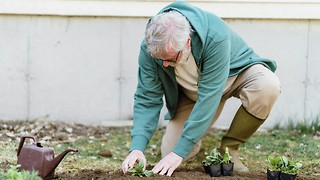Four days in North Korea: part five

We were woken in the morning by the shrill ringing of our telephone, summoning us down for breakfast and to the coach. That morning we were going to the Demilitarised Zone (DMZ), the four kilometre-wide buffer which stretches across the entire peninsula, separating the North and the South. The DMZ suffers from somewhat of a misnomer, as it is the world’s most heavily fortified border, with guard installations and troops actively stationed along its whole length. However, both sides only come face-to-face at the Joint Security Area in the old village of Panmunjom, a military complex where ageing blue huts straddle the border and the countries’ best soldiers are put on display to stare out the enemy. There is a minimum height restriction on the soldiers serving at the DMZ and they must have a black belt either in taekwondo or judo.
We visited a few outbuildings, including where the now-defunct 1953 Armistice Agreement was signed, before being led single-file to the stand-off point where the official border is demarcated by a concrete slab. The North Korean soldiers, in their crisp, olive uniforms and caps, stood resolutely to attention: two facing each other right up against the border with a third behind them with his back to the South. Having grown up in England, it felt very odd to be confronting the U.S.-backed South as my enemy, with the North Korean soldiers around me as protection. The last time I had visited the DMZ from the other side I was grateful the South Korean army was there in such a large number. This time, having already approached the scene from the other side, I didn’t feel this hysteria.

However, when we visited there were no soldiers to be seen guarding their side of the border. Likewise, when I visited from the South there was only one North Korean soldier in the distance. This, I hear, is what happens nowadays. Since the site has evolved into such a lucrative tourist destination for both sides, in a petty move of spite, the other side’s troops go into hiding when they know a tour party is arriving so that the other country is unable to provide the “complete” experience. Plus, I can imagine that after 60-odd years it is rather boring.
Bill Clinton once referred to the DMZ as “the scariest place on earth”, and it’s a slogan the tour operators have capitalised on, but I’m not sure if it reflects the atmosphere there. Sure, the mood is tense, with soldiers in hiding stroking the triggers of their guns and with the potential for all-out war, but as North and South stare each other down in the exact same way they have done for 60 years now, the overarching feeling is one of an eerie stillness. Sometimes tensions are heightened – such as following the sinking of the Cheonan warship in 2010 – when conflict seems more likely, but the place is remarkably quiet and has been for so long that it feels detached from the rest of the world.
That isn’t to say that the Joint Security Area is not an eventful place but that its 60-year history has diluted its sense of activity. In 1976 North Korean soldiers killed two American officers during an operation to trim a poplar tree which obstructed the line of sight between two observation posts. They were murdered with their axes. Also, defections do occur across the DMZ although only four North Koreans have fled to the South this way in the last five years. (Defectors typically follow a dangerous route which takes them through China and onto either Mongolia or Thailand, countries that repatriate to South Korea.) Other incidents seem rather trivial: North Korea built a flagpole precisely 60m taller than the South’s and the South was accused of acting provocatively by illuminating a large steel tower in the shape of a Christmas tree.
Interestingly, I found that visiting the DMZ from North Korea was a much more relaxed affair than from the other side. Travelling to the DMZ from Seoul one encounters more road barriers and more frequent checkpoints, which are more heavily guarded. Moreover, we had to sign a waiver absolving the tour operator of all responsibility arising as a “result of enemy action” and there were strict regulations imposed by the UN on what you could and could not wear. There was none of this from the North, although they were tetchier about photos, which was odd, and arguably pointless, since the DMZ must be the most documented site of the whole peninsula.
Unfortunately, our visit to the DMZ felt rushed and we were soon on our way to Kaesong, the historical capital of the once unified Korea. We visited a museum of the Koryo dynasty, where Ms Ba showed us traditional Korean dress and extolled the virtues of ginseng, claims which the Chinese contingent of the group enjoyed. The displays were exclusively in Korean but we just about figured out an old poster detailing the price of human slaves. (If you’re interested, girls cost more than boys, there’s a 50% discount if they’re old and the exchange rate was eight elderly men for one cow). Again, this was only a fleeting stop before we went to the Tongil (“Reunification”) restaurant for lunch, where we were served 12 little dishes in brass bowls, one of which was just blocks of pure animal fat. Each to their own, I guess.
To read earlier instalments:
Part One http://www.varsity.co.uk/lifestyle/4842
Part Two http://www.varsity.co.uk/lifestyle/4844
Part Three http://www.varsity.co.uk/lifestyle/4845
Part Four http://www.varsity.co.uk/lifestyle/5906
 News / Uni Scout and Guide Club affirms trans inclusion 12 December 2025
News / Uni Scout and Guide Club affirms trans inclusion 12 December 2025 News / Cambridge Vet School gets lifeline year to stay accredited28 November 2025
News / Cambridge Vet School gets lifeline year to stay accredited28 November 2025 Science / Did your ex trip on King’s Parade? The science behind the ‘ick’12 December 2025
Science / Did your ex trip on King’s Parade? The science behind the ‘ick’12 December 2025 News / Cambridge study finds students learn better with notes than AI13 December 2025
News / Cambridge study finds students learn better with notes than AI13 December 2025 News / Pembroke to convert listed office building into accom9 December 2025
News / Pembroke to convert listed office building into accom9 December 2025







